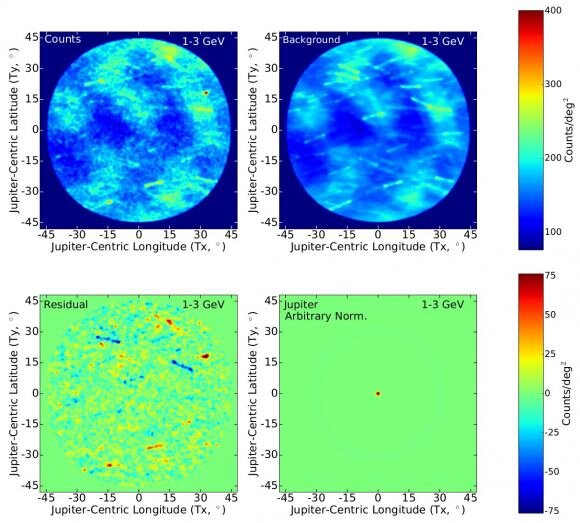
Two astrophysicists said on April 5, 2021, that Jupiter might serve as an ideal detector in the hunt for dark matter, the elusive and mysterious substance thought to make up a substantial fraction of our universe. Stanford University’s Rebecca Leane and Stockholm University’s Tim Linden released a draft version of a new paper on arXiv, describing how that might work. These scientists list two reasons why our solar system’s largest planet might be an advantageous spot to search for dark matter: its size and its temperature. Leane explained:
Because Jupiter has a large surface area compared to other solar system planets, it can capture more dark matter… You might then wonder why not just use the even bigger (and very close by) sun. Well, the second advantage is that because Jupiter has a cooler core than the sun … This in part can stop lighter dark matter from evaporating out of Jupiter, which would have evaporated out of the sun.
Leane and Linden analyzed 12 years of data from the Fermi Telescope – a space observatory that sees the universe in high-energy gamma rays – in what they called:
… the first dedicated gamma-ray analysis of Jupiter.
They didn’t find robust evidence of gamma-ray emission from Jupiter that would’ve suggested dark matter, but they said Jupiter could be a target for future gamma-ray searches.
Dark matter is an elusive substance – detectable via its gravitational influence on objects in space – called dark because no one has ever actually seen any. No one knows what dark matter is. According to a popular cosmological model called the Lambda Cold Dark Matter Model (aka the Lambda-CDM model, or sometimes just the Standard Model), ordinary atoms – the building blocks of our own bodies and all we see around us – make up only only around 5% of the universe. Think of that! Just 5%. The rest of the universe consists of dark energy (68%) and dark matter (27%), according to this popular theory.
So dark matter is very mysterious. It’s possible that it’s an unidentified subatomic particle that interacts in different ways than scientists are used to.
How would Jupiter be a source of dark matter? Rebecca Leane and Tim Linden pointed out that dark matter should be pulled into the gravitational wells of large objects, such as our sun and its largest planets. These scientists said that, eventually, enough dark matter would build up in a star or planet that the dark matter particles would run into each other, causing annihilations of dark matter particles. The gamma rays would be telltale sign of the annihilations. And while we can’t see dark matter, we can see gamma rays, thanks to observatories such as the Fermi Telescope.
The Fermi Telescope, launched in 2008, looks for gamma radiation across the universe, from right here in our solar system to the farthest reaches of space. Fermi investigates black holes, supernovas, and, yes, Jupiter, where it has accumulated 12 years of data that the scientists mined for evidence of gamma rays that might signal the annihilation of dark matter.


While Leane and Linden haven’t found dark matter from Jupiter yet, they did find an intriguing excess of gamma rays at low energy levels on the gas giant. They said they hope to study Jupiter with newer, more powerful telescopes that are still in the concept stage. These new telescopes would perform better at the lower end of their studies, where Fermi struggles.
Leane thinks their method of looking for dark matter could be extrapolated out to exoplanets and brown dwarfs. Future studies would target these objects that are nearer to the center of the galaxy, where scientists believe more dark matter resides. The scientists think these objects would appear hotter in infrared than planets and stars further away, due to more frequent dark matter annihilation in their cores. They hope that the James Webb Space Telescope, which is scheduled to launch later this year, can provide an infrared survey to confirm their theory.
Thus, despite the dim nature of dark matter, the possibility of future discoveries looks a bit brighter now.

Bottom line: Jupiter’s large size and cool core make it an excellent target in the search for dark matter. A team of scientists analyzed gamma-ray data from the Fermi Telescope looking for signs of the elusive substance.
Source: First Analysis of Jupiter in Gamma Rays and a New Search for Dark Matter











